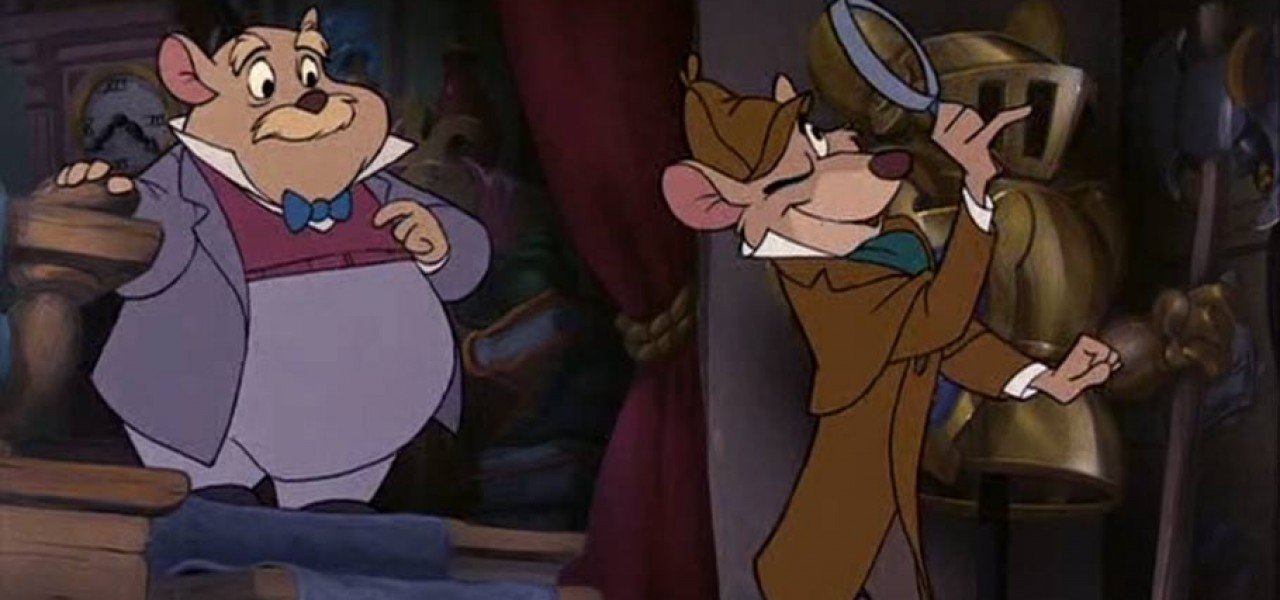
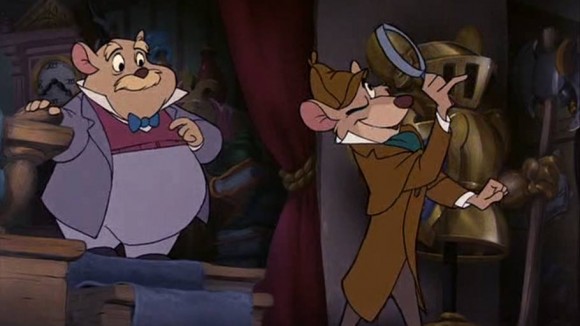
‘Mouse in Transition’: ‘Basil’ Kicks Into High Gear (Chapter 13)

New chapters of Mouse in Transition are published weekly on Cartoon Brew. It is the story of Disney Feature Animation—from the Nine Old Men to the coming of Jeffrey Katzenberg. Ten lost years of Walt Disney Production’s animation studio, through the eyes of a green animation writer. Steve Hulett spent a decade in Disney Feature Animation’s story department writing animated features, first under the tutelage and supervision of Disney veterans Woolie Reitherman and Larry Clemmons, then under the watchful eye of young Jeffrey Katzenberg. Since 1989, Hulett has served as the business representative of the Animation Guild, Local 839 IATSE, a labor organization which represents Los Angeles-based animation artists, writers and technicians.
Read Chapter 1: Disney’s Newest Hire
Read Chapter 2: Larry Clemmons
Read Chapter 3: The Disney Animation Story Crew
Read Chapter 4: And Then There Was…Ken!
Read Chapter 5: The Marathon Meetings of Woolie Reitherman
Read Chapter 6: Detour into Disney History
Read Chapter 7: When Everyone Left Disney
Read Chapter 8: Mickey Rooney, Pearl Bailey and Kurt Russell
Read Chapter 9: The CalArts Brigade Arrives
Read Chapter 10: Cauldron of Confusion
Read Chapter 11: Rodent Detectives and Studio Strikes
Read Chapter 12: Disney Dead-Ends and Lucrative Mexican Caterpillars
When the Disney strike of 1982 ended and the story artists returned to their respective work spaces in the animation building, Basil of Baker Street was still running along two sets of tracks. There were storyboards filled with gags and character bits, and boards filled with plot points.
In the crew’s absence, director John Musker had pinned a lot of witty drawings with the lead characters to various cork boards, and Vance Gerry snuck away from The Black Cauldron to look at everything that had been done. He appreciated all the sight gags, but suggested we concentrate on pulling the story together and leave the jokes until later. (Chief Executive Officer Ron Miller came down from his corner office for a meeting and voiced the same sentiment.)
So, putting continuity up from start to finish was what we concentrated on. Eve Titus’s book had a few scenes we could use (most of which were later dropped), but mostly we invented new plot. Since the lead was a 19th century rodent sleuth, we needed a sufficiently colorful crime for him to investigate. We racked our brains over what that crime might be, and how it would unfold. We settled on a toy-making mouse getting kidnapped by sinister forces, and unspooled the story from there. (This wasn’t a plot device that everyone was crazy about: “Hey! Didn’t The Rescuers ALSO have a kidnapping? And Mice?! Why are we doing the kidnapping thing AGAIN?”)
One way or the other, we did it again. But what distinguished Basil (later known as The Great Mouse Detective) was the ultimate “bigness” of the tale, and the way the story was shaped. No screenplay. No detailed synopsis. We went at the story visually, with Pete Young putting up scenics that we knew we wanted in the movie: Basil inside Big Ben. Basil at Buckingham Palace. Basil at the London Bridge…in a toy store…in a balloon chase over London.
From the visuals, we stitched plot and character strands together and wound them through our locations. Buckingham Palace suggested a Mouse Queen and court intrigue; the tower clock made us think of gears, springs, and a chase/battle through the clockworks. (Hadn’t the studio used similar elements to good effect in Clock Cleaners? With a three-foot mouse?)
As the story expanded, so did our need to cast voices for the two principals: Basil and Dr. Dawson. Basil’s sidekick, David Q. Dawson, turned out to be simple to cast. Ron Clements had character actor Val Bettin in mind, and after a short try-out he got the part.
Basil turned out to be way harder to nail down. We went through days and weeks of voice testing, but none of the actors who came in to read had the manic spark and energy we were looking for. Some didn’t have the proper Brit accent; others didn’t have the vocal rhythms or lilt we were after.
About the time we started wondering if there was anybody in Los Angeles suited for the role, Barrie Ingham walked through the recording stage door. Mr. Ingham was a Royal Shakespeare-trained actor with lots of stage and film experience. Wiry and sandy-haired, he had toured with Richard Harris in Camelot, and was in Tinsel Town (in fact, living there) exploring film work.
And Mr. Ingham nailed the part of the brainy mouse detective within six minutes. His audition was so compelling, in fact, that part of it was used in the finished feature.
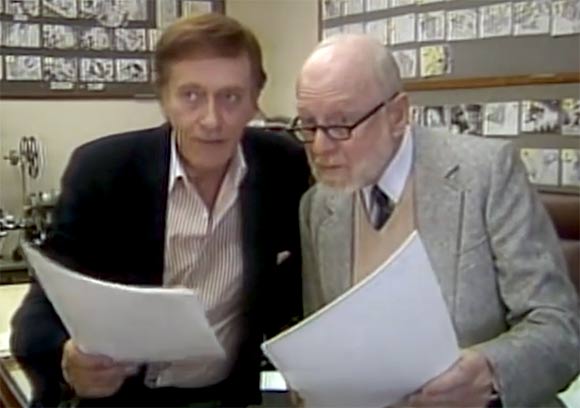
With some of the lead voices cast, a few animators downstairs started doing character designs and test animation; also, more directors came aboard. Veteran Dave Michener started on the project as Director Number Two, and then Burny Mattinson, came on as the third helmer after his maiden directorial stint on Mickey’s Christmas Carol wrapped up.
Mr. Mattinson had an inspired idea right out of the gate. He looked at the roster of characters and suggested that Ratigan, the villain of the piece, be developed along the lines of larger-than-life corporate chieftain Burnbridge Waters from the 1950 comedy Champagne for Caesar.
I had never heard of the film, but as soon as I saw it I realized Burny’s idea was perfect. Waters was a whacked-out soap magnate scheming to do in hero Ronald Colman. He was played by Vincent Price, and when the story crew saw Waters in action, the core essence of Ratigan swam into focus: He would be large, flamboyant, and barrel-chested. He would be scheming, explosive, and semi-insane. And, of course, the actor to portray him would have to be Vincent Price.
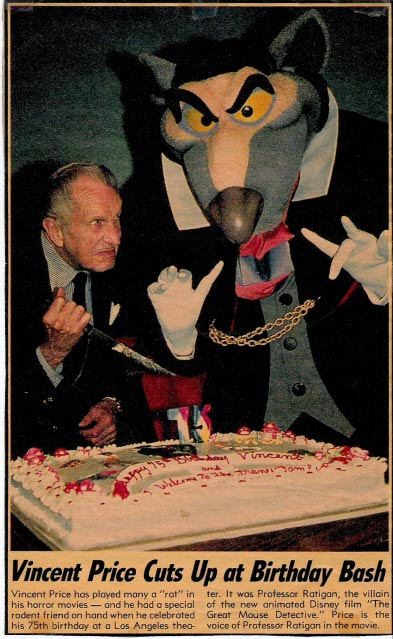
I wondered for half a minute if the studio would be able to sign Mr. Price, but it wasn’t a problem. Vincent Price turned out to be up for almost ANY kind of role. And when I met Mr. Price for the first time at the studio front gate, he explained his philosophy of “How to be a successful actor in Hollywood” to me:
“You know, if you’re going to work and survive in this business, you have to work it like a popularity contest. You can’t be difficult. You’ve got to be willing to work in anything and everything. Movies, T.V., documentaries, cartoons. EVERYTHING. Because you never know where the next job is coming from. Or if the next job will be your last.”
Vincent Price practiced what he espoused. On the recording stage he was amiable and upbeat, spinning funny (and doubtless well-practiced) stories of Hollywood:
“The Ten Commandments went on filming FOREVER. It went on so long that near the the end, two actresses asked, ‘Who do you have to fuck to get off this picture?”
“Errol Flynn wouldn’t know his dialogue half the time. But he had a method in it. He would blow his lines in the master shot, then they’d have to reshoot his dialogue in close-up.”
Only twice did Mr. Price get testy. One day between takes, he was talking about The Big Circus, a Technicolor extravaganza in which he appeared during the 1950s. I burst forth: “The Big Circus? I loved that movie! I saw it at the Montrose theater when I was a kid!”
Price glared at me frostily and growled: “Thanks a lot.” (I don’t think he was being jocular.)
The other moment of testiness happened when he had delivered a four-word line thirty-five times in thirty-five different ways, and the directors asked for a thirty-sixth interpretation. Mr. Price snapped, “I don’t have any other way to say it! I’ve said the line every way there is!”
Sequence by sequence, the characters and storyline for Basil of Baker Street were coming together. Glen Keane and his able assistant Matt O’Callaghan (who today is a veteran director) took charge of Ratigan, adding pizzazz to what Vincent Price was bringing to the table. Glen designed the character, partially modeled on Burnbridge Waters in Caesar. Glen and Matt boarded a couple of Ratigan’s sequences, including one of the evil-doer taking over the mouse part of Buckingham Palace, making a grand announcement to the rabble that things were going to be way different now that Ratigan (with an assist from a mechanical queen mouse) was in charge.
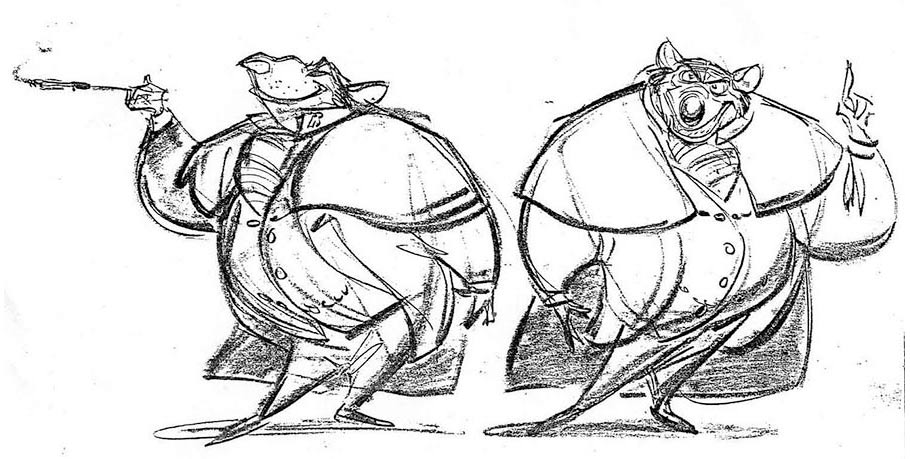
A new board artist named Bruce Morris expanded Basil’s and Dawson’s hair-breadth escape from Ratigan’s death-trap into a comedic, Rube-Goldberg style tour-de-force, with Basil out-thinking the big rat’s murderous contraption. (Bruce had been given the bare bones of a plot point—“Basil escapes Ratigan’s clutches”—and turned it into a riveting five-minute sequence.)
Meantime, I was writing script, working with board artists on gags and dialogue, and rejiggering lines on the recording stage. I continued to be amazed at Barrie Ingham’s work in front of the microphone. Mr. Ingham never delivered a line the same way twice. One day he was asked to repeat a chunk of dialogue 200 times, and varied each and every reading, adding different nuance and shading each time through.
At lunch, Mr. Ingham regaled us with stories of the London stage: “There are two school for acting Shakespeare in Britain. One school goes for the sound and symphonic majesty of Shakespeare’s verse; the other school aims to make the meaning of the lines clear, to enable the audience to understand the text. I come from the ‘clarity’ school.”
And Mr. Ingham talked about touring with the Broadway musical Camelot, going from theaters in Cleveland one week to huge outdoor amphitheaters in Colorado the next. “You have to slow everything down in the big, uncovered places. In a theater your timing and gestures are smaller. In a huge amphitheater you have to play everything big, also slower. The laughs will start down in front and then roll up to the back, then roll down again. And you have to stop what you’re doing and wait for all that. It changes your performance a lot.”
The weeks and months glided by. Much to the crew’s amazement, story reels went up seamlessly and pencil-test animation (early, experimental stuff) began to be cut in. Nobody was having big fights over what direction the movie should take; nobody was grabbing sequences away from somebody else.
Upper management was so pleased with the picture’s progress that Burny Mattinson was promoted to producer and story artist Ron Clements got elevated into Burny’s vacated director slot. (Basil, unlike Disney features in the 1990s, had three directors, and they were John Musker, Dave Michener, and Ron Clements. Ron and John worked together on the movie, but were not yet the powerhouse writer-director team they would later become.)
For me, Basil of Baker Street was the best working experience of my Disney career. No senior writer was looking over my shoulder giving helpful suggestions, and I actually got listened to in story meetings. Mattinson liked the sequence scripts I was writing, and Pete Young and I were working hand in glove, creating dialogue and storyboard elements in the morning and going on long lunchtime walks through Burbank neighborhoods during the noon hour, talking about life. And it was fun (if nerve-wracking) to sit on the recording stage while the actors emoted, and having to come up with fresh dialogue on the fly.
Things were going so well that I started thinking, “This is what I was born to do. This is the way existence was meant to be.”
So, of course, life soon changed drastically. And the whole rhythm and structure of sleepy Walt Disney Productions was turned upside down.
Mouse in Transition will soon be out in e-book and paperback formats from Theme Park Press. In addition to Hulett’s on-going narrative, the book will contain a foreword by Disney director John Musker, a half-dozen interviews with Disney old-timers, and biographical sketches of Disney animation staffers who worked at the studio in the 1970s and ’80s.

.png)